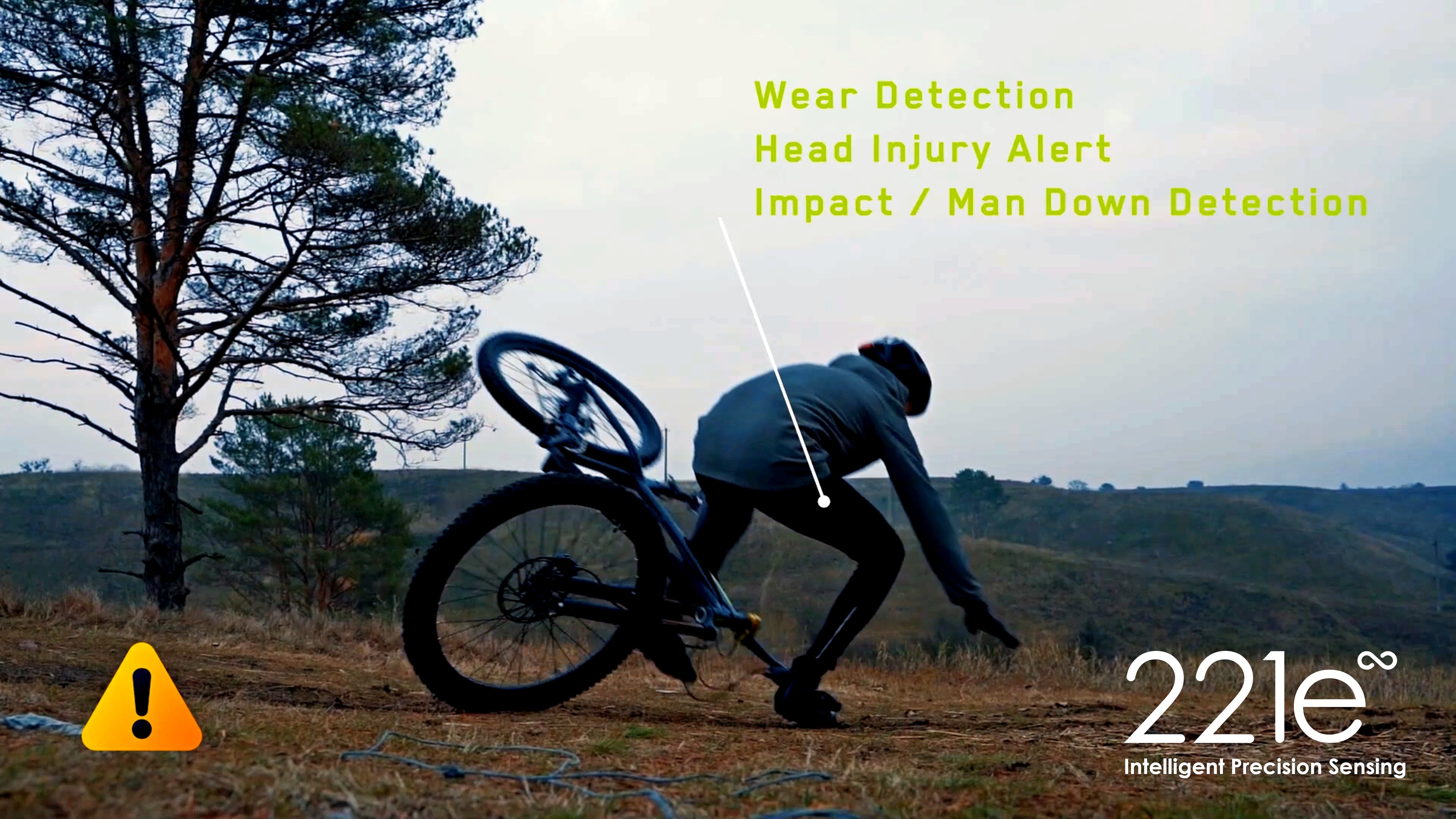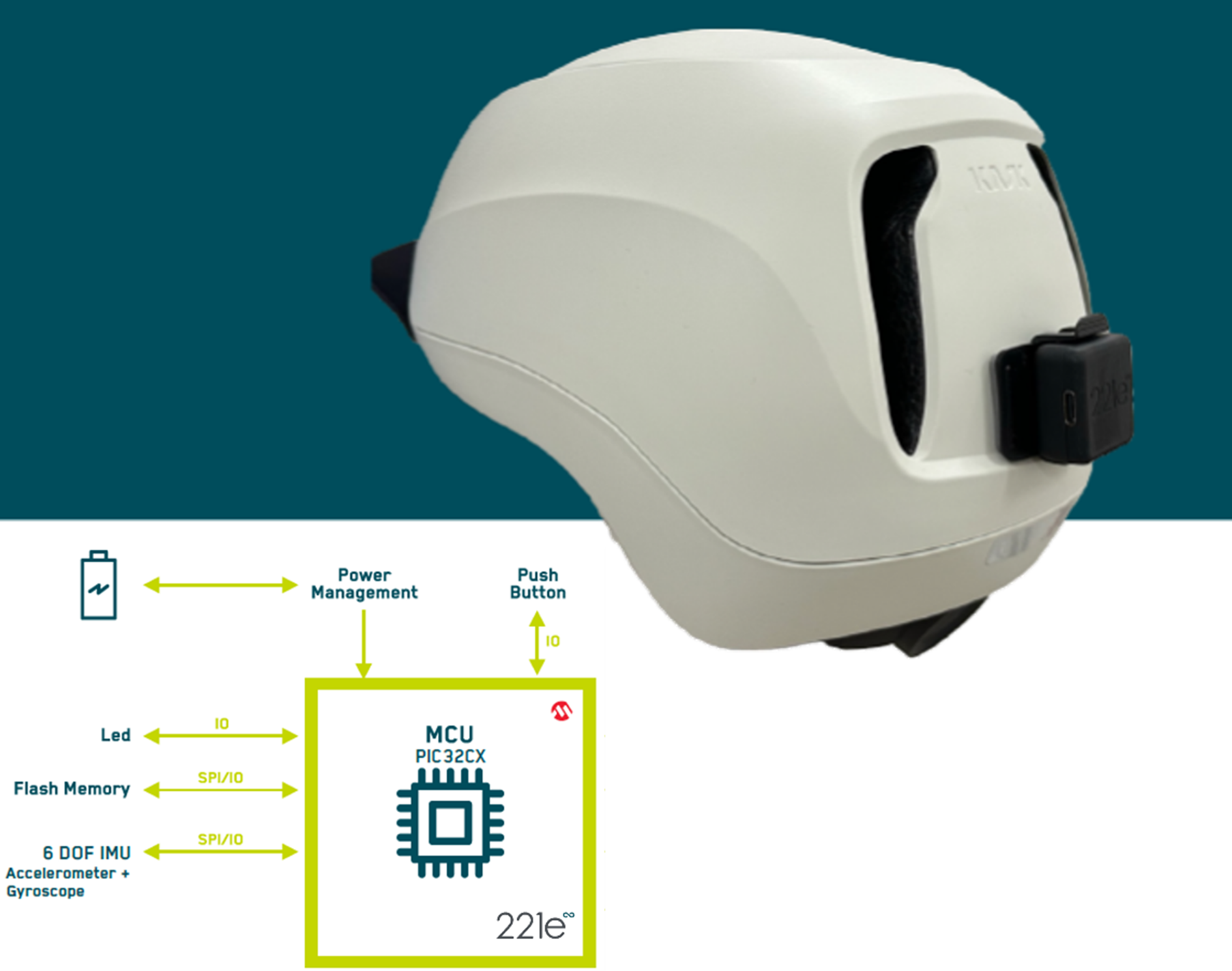Check out an innovative Smart Helmet Reference Design from Microchip Design Partner 221e which combines advanced IMU technology with edge AI monitoring capabilities.
The surge in e-mobility adoption has brought unprecedented safety challenges, with incidents rising by 40%, and over 60% of users expressing safety concerns. As a Microchip Design Partner, 221e addresses these challenges through an innovative Smart Helmet Reference Design that combines advanced IMU technology with edge AI monitoring capabilities.
 |
Demonstrating wear, impact and fall detection.
Market-Driven Innovation
The e-mobility landscape faces critical adoption barriers, including complex EU regulations and insurance considerations. 221e's reference design is built on three key capabilities that ensure comprehensive safety, which is a top concern for users:
- Rider safety monitoring:
Rider safety monitoring starts with wear detection, verifying if the helmet is being worn correctly and securely fastened.
NeuraSense™ embedded algorithms then enable impact and fall detection, analyzing data to detect incidents. Upon understanding the severity of the impact, an emergency alert is activated if necessary, and detailed information is sent so the user can receive assistance.
- Road condition classification:
Riding on two or three wheels requires awareness of road conditions. The integrated sensors in the Smart Helmet continuously monitor and record the condition of the road, detecting factors like potholes and uneven terrain. This data helps assess travel suitability, while also enhancing rider safety.
- Micromobility black-box functionality:
Data-driven insights play a significant role in road safety. In the event of an accident, the sensors embedded in the smart helmet serve as a black box, helping to reconstruct the incident. This becomes a key component in insurance claims, as it provides access to objective, reliable data rather than relying on subjective accounts of the event. Such data not only safeguards the rider but also any other parties involved on a legal basis. The system’s advanced impact classification capabilities allow for a detailed assessment of the severity. The edge AI algorithms estimate the potential level of a concussion, indicated by the intensity and the angle at which the impact occurred.
Read more about IMU sensor fusion, Edge AI software and mobility safety solutions on the 221e website.
Technical Architecture
At the heart of the solution lies Microchip's PIC32CK MCU, orchestrating a sophisticated sensor network. The core system integrates:
- 6 DOF IMU combining accelerometer and gyroscope for precise motion tracking
- Flash memory for reliable data logging and BLE
- Streamlined power management system
- LED indicator and push button interface
Enhanced Capabilities
The design's modular approach allows manufacturers to enhance capabilities through optional sensors:
- 3D magnetometer for enhanced directional awareness: Useful for turn signal automation or in cases where cities have enabled geofencing to alert users when entering restricted zones or suggest safer routes.
- MEMS microphone for environmental monitoring: The microphone can detect a loud impact that signifies a crash and combines it with accelerometer data to trigger automatic emergency alerts.
- HDR accelerometer for expanded motion detection: By distinguishing between normal riding vibrations and sudden impacts, it can detect falls and crashes with higher accuracy, combining with edge AI to reduce false positives. It also assesses the rider’s posture and movements, providing warnings if instability is detected (e.g., swaying due to fatigue or hazardous road conditions).
- Environmental sensors for comprehensive ambient data: If the ambient light sensor detects low-light conditions, it can automatically turn on helmet-mounted LEDs for enhanced visibility.
 |
A block diagram of the smart helmet reference design.
Accurate Fall Detection
The system operates in three phases to detect and analyze a potential fall. They proceed in the following order:
- Phase Alpha: If the rider is able to move and return to an upright position, the system deactivates the "man-down" alert, resumes normal monitoring and doesn’t initiate an emergency response.
- Phase Bravo: If the rider remains down too long, the system interprets this as a potential injury and progresses to the next level, indicating the need for assistance.
- Phase Charlie: The system triggers an emergency call and sends detailed information about the rider’s location to ensure prompt help can be dispatched.
With an accuracy of 99.7%, the system drastically reduces false alarms so that help is sent and received exactly when and where it is needed.
The NeuraSafe™ edge AI algorithms combine multiple sensor inputs to enable deeper insights and better accuracy. Rather than using large amounts of general data, NeuraSafe is developed using top-quality context-specific data designed for fall-detection applications. Thanks to its operation on the edge, it also ensures minimal power consumption, which is a crucial factor that addresses range anxiety in micromobility users.
Industry Impact
For manufacturers and mobility providers, 221e's Smart Helmet Reference Design offers hassle-free integration with existing products while ensuring regulatory compliance and future expandability.
The platform's comprehensive sensor array and MCU architecture enable insurers to develop data-driven risk models and usage-based policies. This, in turn, creates value for both manufacturers and insurance providers through enhanced safety monitoring and streamlined claims processing.
This reference design extends beyond micromobility to industries such as construction, manufacturing and first responders, where personal protection and real-time monitoring are critical. The modular sensor platform can be adapted for safety helmets, enabling fall detection and environmental hazard detection to improve worker safety and compliance in high-risk environments.

